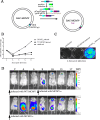Cytomegalovirus-vectored COVID-19 vaccines elicit neutralizing antibodies against the SARS-CoV-2 Omicron variant (BA.2) in mice
- PMID: 37971259
- PMCID: PMC10883801
- DOI: 10.1128/spectrum.02463-23
Cytomegalovirus-vectored COVID-19 vaccines elicit neutralizing antibodies against the SARS-CoV-2 Omicron variant (BA.2) in mice
Abstract
Cytomegalovirus (CMV) has been used as a novel viral vector for vaccine development and gene therapy. Coronavirus disease 2019 is an infectious disease caused by the SARS-CoV-2 virus, which is highly mutable and is still circulating globally. The study showed that the CMV viral vector caused transient systemic infection and induced robust transgene expression in vivo. CMV vectors expressing different SARS-CoV-2 proteins were immunogenic and could elicit neutralizing antibodies against a highly mutated Omicron variant (BA.2). The expression level of receptor-binding domain (RBD) protein was higher than that of full-length S protein using CMV as a vaccine vector, and CMV vector expression RBD protein elicited higher RBD-binding and neutralizing antibodies. Moreover, the study showed that CMV-vectored vaccines would not cause unexpected viral transmission, and pre-existing immunity might impair the immunogenicity of subsequent CMV-vectored vaccines. These works provide meaningful insights for the development of a CMV-based vector vaccine platform and the prevention and control strategies for SARS-CoV-2 infection.
Keywords: SARS-CoV-2; cytomegalovirus; immunogenicity evaluation; variant of concern; viral vector-based vaccine.
Conflict of interest statement
The authors declare no conflict of interest.
Figures




Similar articles
-
A mosaic-type trimeric RBD-based COVID-19 vaccine candidate induces potent neutralization against Omicron and other SARS-CoV-2 variants.Elife. 2022 Aug 25;11:e78633. doi: 10.7554/eLife.78633. Elife. 2022. PMID: 36004719 Free PMC article.
-
A Glycosylated RBD Protein Induces Enhanced Neutralizing Antibodies against Omicron and Other Variants with Improved Protection against SARS-CoV-2 Infection.J Virol. 2022 Sep 14;96(17):e0011822. doi: 10.1128/jvi.00118-22. Epub 2022 Aug 16. J Virol. 2022. PMID: 35972290 Free PMC article.
-
Pre-Omicron Vaccine Breakthrough Infection Induces Superior Cross-Neutralization against SARS-CoV-2 Omicron BA.1 Compared to Infection Alone.Int J Mol Sci. 2022 Jul 12;23(14):7675. doi: 10.3390/ijms23147675. Int J Mol Sci. 2022. PMID: 35887023 Free PMC article.
-
Neutralizing antibody levels associated with injectable and aerosolized Ad5-nCoV boosters and BA.2 infection.BMC Med. 2023 Jul 3;21(1):233. doi: 10.1186/s12916-023-02942-3. BMC Med. 2023. PMID: 37400857 Free PMC article.
-
Exploring the Potential of Cytomegalovirus-Based Vectors: A Review.Viruses. 2023 Oct 2;15(10):2043. doi: 10.3390/v15102043. Viruses. 2023. PMID: 37896820 Free PMC article. Review.
Cited by
-
Can Humanized Immune System Mouse and Rat Models Accelerate the Development of Cytomegalovirus-Based Vaccines Against Infectious Diseases and Cancers?Int J Mol Sci. 2025 Mar 27;26(7):3082. doi: 10.3390/ijms26073082. Int J Mol Sci. 2025. PMID: 40243710 Free PMC article. Review.
-
Precision in Action: The Role of Clustered Regularly Interspaced Short Palindromic Repeats/Cas in Gene Therapies.Vaccines (Basel). 2024 Jun 7;12(6):636. doi: 10.3390/vaccines12060636. Vaccines (Basel). 2024. PMID: 38932365 Free PMC article. Review.
References
-
- Wu F, Zhao S, Yu B, Chen Y-M, Wang W, Song Z-G, Hu Y, Tao Z-W, Tian J-H, Pei Y-Y, Yuan M-L, Zhang Y-L, Dai F-H, Liu Y, Wang Q-M, Zheng J-J, Xu L, Holmes EC, Zhang Y-Z. 2020. A new coronavirus associated with human respiratory disease in China. Nature 580:265–269. doi:10.1038/s41586-020-2202-3 - DOI - PMC - PubMed
-
- Wu S, Zhong G, Zhang J, Shuai L, Zhang Z, Wen Z, Wang B, Zhao Z, Song X, Chen Y, Liu R, Fu L, Zhang J, Guo Q, Wang C, Yang Y, Fang T, Lv P, Wang J, Xu J, Li J, Yu C, Hou L, Bu Z, Chen W. 2020. A single dose of an adenovirus-vectored vaccine provides protection against SARS-CoV-2 challenge. Nat Commun 11:4081. doi:10.1038/s41467-020-17972-1 - DOI - PMC - PubMed
MeSH terms
Substances
Supplementary concepts
Grants and funding
LinkOut - more resources
Full Text Sources
Medical
Miscellaneous

